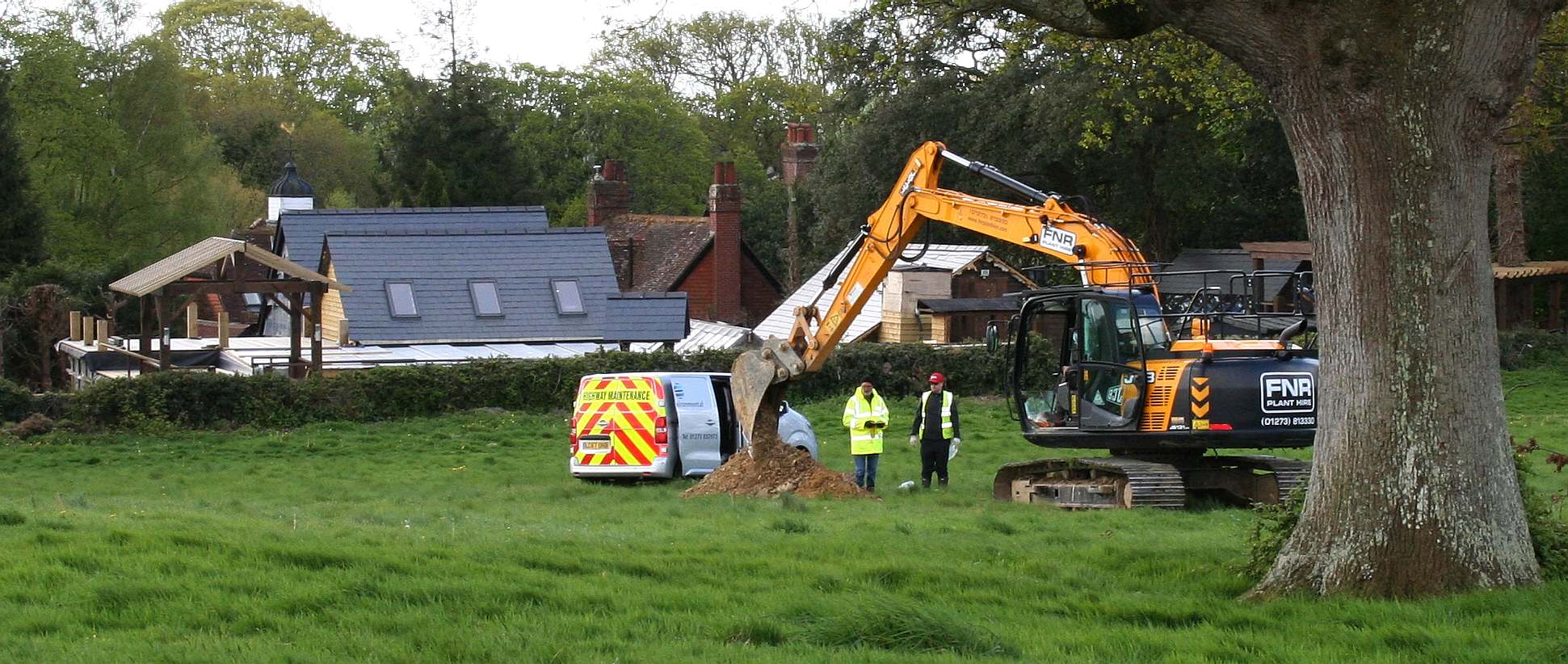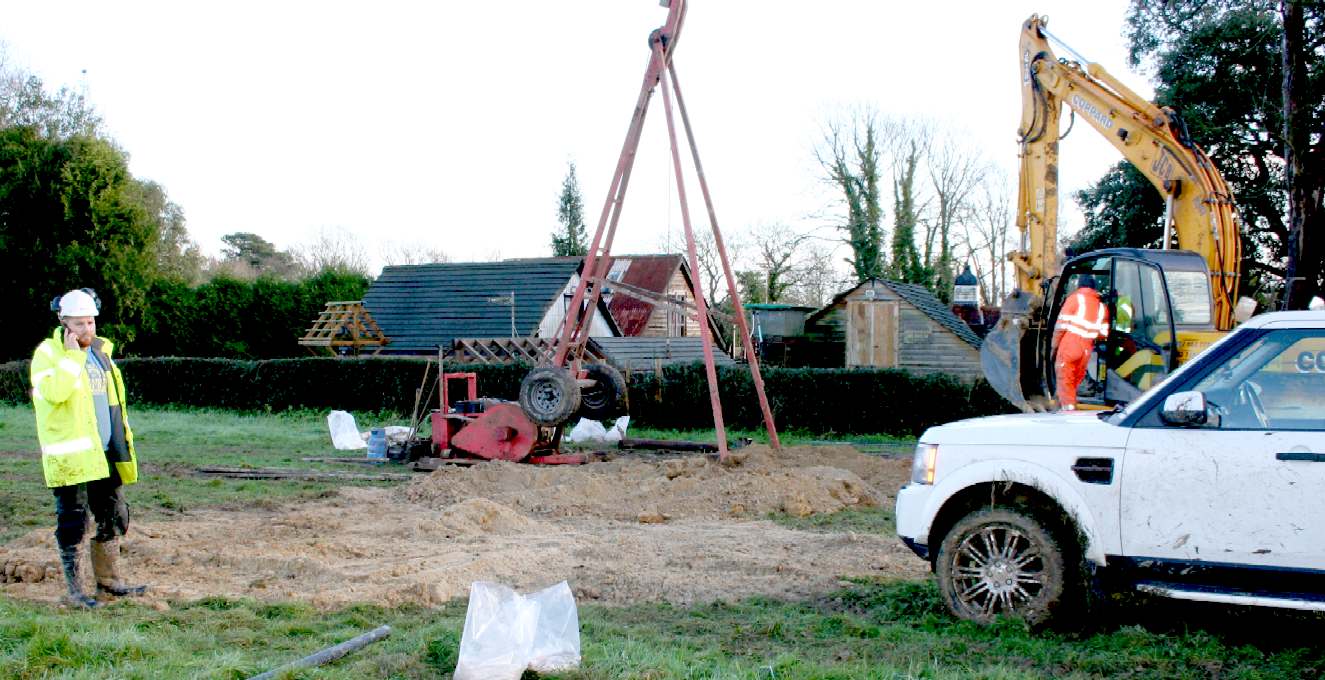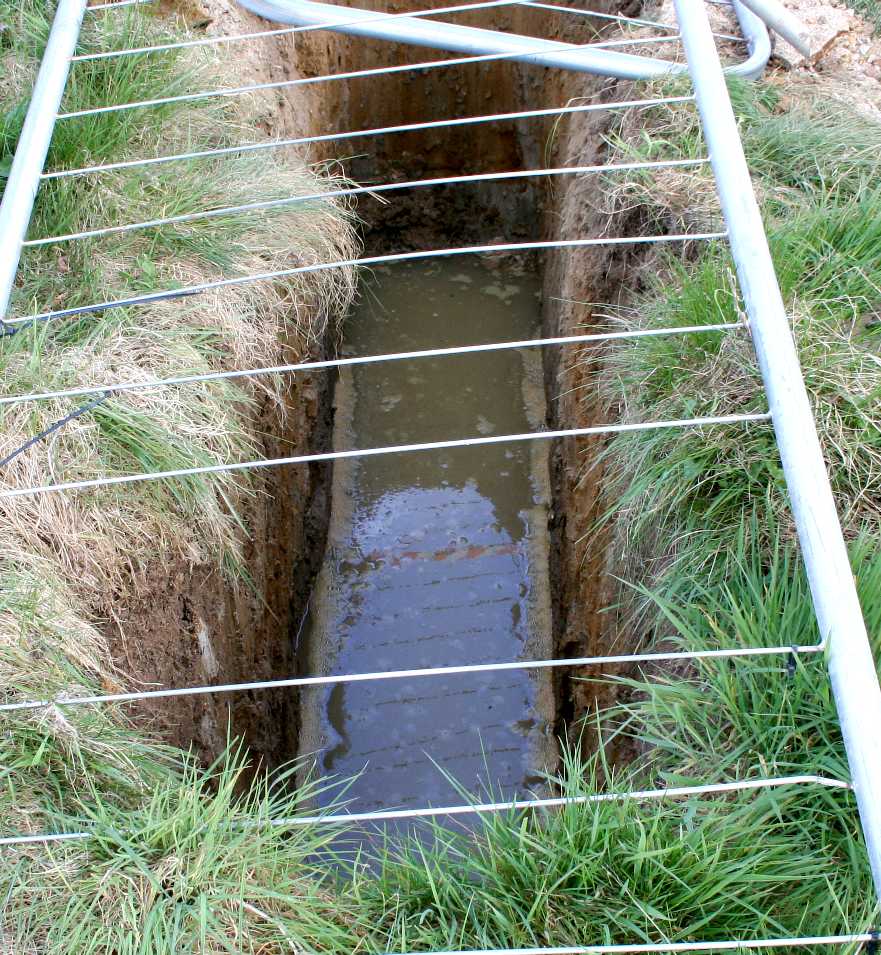|

WATER
RIGHTS - Clarion Housing Group and Thakeham
Homes are in danger of spoiling an ancient well that supplies water
to many concerns in this vicinity. In the picture you can see a hired
digger scooping out trenches to test drainage by pouring in water and
measuring the rate of absorption by the soil. It seems to us that if you
build houses on the ground that feeds the ancient well, that
contamination from garden treatments such as Roundup and engine oils,
etc., will find its way into this well leading to claims against the
owners of the houses who would have been sold a pup, and/or against the
Council for approving the proposal, by way of a negligence claim, and/or
against the vendors or developers. Any way you look at it the developers
and Council concerned should take steps to ensure that no development
takes place until the proper tests and evaluations have been completed,
and after that stage, to ensure that any houses built in this location
will not be on a path that includes the water
table that feeds the ancient well.
Any
failure to conduct the proper tests and house situation, along with safe
sewage disposal, may tempt the Secretary
of State to call in the application. We imagine that all of those
with a financial interest in this piece of greenbelt will want to
resolve issues before it starts to get complicated.
2.
ENSURING THE VITALITY OF TOWN CENTRES
23. Planning policies should be positive, promote competitive town centre
environments and set out policies for the management and growth of
centres over the plan period. In drawing up Local Plans, local planning
authorities should:
●● recognise town centres as the heart of their communities and pursue
policies to support their viability and vitality;
●● define a network and hierarchy of centres that is resilient to anticipated
future economic changes;
●● define the extent of town centres and primary shopping areas, based on a
clear definition of primary and secondary frontages in designated
centres,
and set policies that make clear which uses will be permitted in such
locations;
●● promote competitive town centres that provide customer choice and a
diverse retail offer and which reflect the individuality of town centres;
●● retain and enhance existing markets and, where appropriate, re-introduce
or create new ones, ensuring that markets remain attractive and
competitive;
●● allocate a range of suitable sites to meet the scale and type of retail,
leisure, commercial, office, tourism, cultural, community and residential
development needed in town centres. It is important that needs for retail,
leisure, office and other main town centre uses are met in full and are not
compromised by limited site availability. Local planning authorities should
therefore undertake an assessment of the need to expand town centres to
ensure a sufficient supply of suitable sites;
●● allocate appropriate edge of centre sites for main town centre uses that
are well connected to the town centre where suitable and viable town
centre sites are not available. If sufficient edge of centre sites cannot be
identified, set policies for meeting the identified needs in other accessible
locations that are well connected to the town centre;
●● set policies for the consideration of proposals for main town centre uses
which cannot be accommodated in or adjacent to town centres;
●● recognise that residential development can play an important role in
ensuring the vitality of centres and set out policies to encourage residential
development on appropriate sites; and
●● where town centres are in decline, local planning authorities should plan
positively for their future to encourage economic activity.
24. Local planning authorities should apply a sequential test to planning
applications for main town centre uses that are not in an existing centre and
are not in accordance with an up-to-date Local Plan. They should require
applications for main town centre uses to be located in town centres, then in
edge of centre locations and only if suitable sites are not available should out
of centre sites be considered. When considering edge of centre and out of
centre proposals, preference should be given to accessible sites that are well
connected to the town centre. Applicants and local planning authorities
should demonstrate flexibility on issues such as format and scale.
25. This sequential approach should not be applied to applications for small scale
rural offices or other small scale rural development.
26. When assessing applications for retail, leisure and office development outside
of town centres, which are not in accordance with an up-to-date Local Plan,
local planning authorities should require an impact assessment if the
development is over a proportionate, locally set floorspace threshold (if there
is no locally set threshold, the default threshold is 2,500 sq m). This should
include assessment of:
●● the impact of the proposal on existing, committed and planned public and
private investment in a centre or centres in the catchment area of the
proposal; and
●● the impact of the proposal on town centre vitality and viability, including
local consumer choice and trade in the town centre and wider area, up to
five years from the time the application is made. For major schemes where
the full impact will not be realised in five years, the impact should also be
assessed up to ten years from the time the application is made.
27. Where an application fails to satisfy the sequential test or is likely to have
significant adverse impact on one or more of the above factors, it should be
refused.
CONTACTS
Department for Communities and Local Government
Eland House
Bressenden Place
London,
SW1E 5DU
United
Kingdom
Telephone: 030 3444 0000

HINKLEY,
CALIFORNIA - GROUND WATER CONTAMINATION - The
town of Hinkley, California,
located in the Mojave Desert, (about 121 miles driving distance
north-northeast of Los Angeles) had its groundwater contaminated with
hexavalent chromium starting in 1952, resulting in a legal case
against Pacific Gas & Electric (PG&E) and a multimillion-dollar
settlement in 1996. The legal case was dramatized in the film Erin
Brockovich, released in 2000.
Residents of Hinkley filed a class action against PG&E,
encaptioned Anderson, et al. v. Pacific Gas and Electric (Superior Ct.
for County of San Bernardino, Barstow Division, file BCV 00300.
In 1993, Erin Brockovich, a legal clerk to lawyer Edward L. Masry,
investigated the apparent elevated cluster of illnesses in the
community linked to hexavalent chromium. The efforts of Brockovich and
Masry, and the plight of the people of Hinkley, became widely known
when the film Erin Brockovich was released in 2000.


After
many arguments, the case was referred to arbitration with maximum
damages of $400 million. After the arbitration for the first 40 people
resulted in roughly $110 million,
PG&E reassessed its position and decided to end arbitration and
settle the entire case. The case was settled in 1996 for $333 million,
the largest settlement ever paid in a direct-action lawsuit in U.S.
history.
In 2006, PG&E agreed to pay $295 million to settle cases involving
another 1,100 people statewide for hexavalent chromium-related claims.
In 2008, PG&E
settled the last of the cases involved with the Hinkley claims for $20
million.
LEAD
CASE: In the case of Wealden
District Council and planning application WD/2015/0090/MAO,
originally filed by Tim
Watson in 2014, then re-filed by Gleeson
Developments in 2015, and taken over by Clarion
Group and Thakeham
Group, there appear to be multiple errors in applying these
policies to greenbelt, including failing to protect open spaces and
the historic built environment, and not promoting sustainable
transport.
The
Horse
Sanctuary Trust are following this case with much interest. We
consider that the paper trail will eventually make interesting
reading, leading us to who is making the decisions and the money
........

GREENBELT
- Digging up Greenfield sites for quick
profits from windfall planning consents is ruining the heritage of
the nation. Once it is gone, it is gone. Britain is short of genuinely
affordable housing that developers are loath to provide where all they
want is the money. It may be that Clarion Housing and Thakeham intend
building affordable units on this site. They should also bear in mind
the requirement for sustainable development in United
Nations terms. Copyright photograph © April 26 2018, Herstmonceux
Museum Limited. All rights reserved. You may not copy this picture
except for educational
use.
|




